Attached files
| file | filename |
|---|---|
| 8-K - FORM 8-K - Tower Group International, Ltd. | y92298e8vk.htm |
Exhibit 99.1
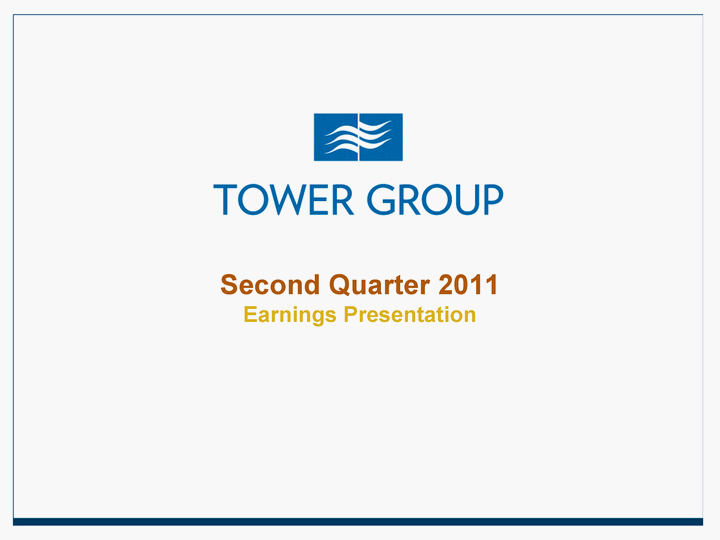
| 1. Second Quarter 2011 Earnings Presentation |

| Forward-Looking Statements The Private Securities Litigation Reform Act of 1995 provides a "safe harbor" for forward-looking statements. This presentation and any other written or oral statements made by or on behalf of Tower may include forward-looking statements that reflect Tower's current views with respect to future events and financial performance. All statements other than statements of historical fact included in this presentation are forward-looking statements. Forward-looking statements can generally be identified by the use of forward-looking terminology such as "may," "will," "plan," "expect," "project," "intend," "estimate," "anticipate," "believe" and "continue" or their negative or variations or similar terminology. All forward-looking statements address matters that involve risks and uncertainties. Accordingly, there are or will be important factors that could cause the actual results of Tower to differ materially from those indicated in these statements. Please refer to Tower's filings with the SEC, including among others Tower's Annual Report on Form 10-K for the year ended December 31, 2010 and subsequent filings on form 10-Q, for a description of the important factors that could cause the actual results of Tower to differ materially from those indicated in these statements. Forward-looking statements speak only as of the date on which they are made, and Tower undertakes no obligation to update publicly or revise any forward-looking statement, whether as a result of new information, future developments or otherwise. Notes on Non-GAAP Financial Measures Operating income excludes realized gains and losses, acquisition-related transaction costs and the results of the reciprocal business, net of tax. This is a common measurement for property and casualty insurance companies. We believe this presentation enhances the understanding of our results of operations by highlighting the underlying profitability of our insurance business. Additionally, these measures are a key internal management performance standard. Operating earnings per share is operating income divided by diluted weighted average shares outstanding. Operating return on equity is annualized operating income divided by average common stockholders' equity. Total premiums include gross premiums written through our insurance subsidiaries and produced as managing general agent on behalf of other insurance companies. Other Notes In October 2010, the Financial Accounting Standards Board issued new guidance concerning the accounting for costs associated with acquiring or renewing insurance contracts. Under the new guidance, only direct incremental costs associated with successful insurance contract acquisitions or renewals are deferrable. We have adopted this guidance early, effective January 1, 2011, and have retrospectively adjusted our previously issued financial information. Adoption of this guidance reduced the carrying value of our deferred acquisition costs as of December 31, 2010, by $78.7 million and Tower Group Inc. stockholders' equity by $42.6 million. Diluted earnings per share for the second quarter 2010 were reduced by $0.05 per share as a result of this change in accounting. |
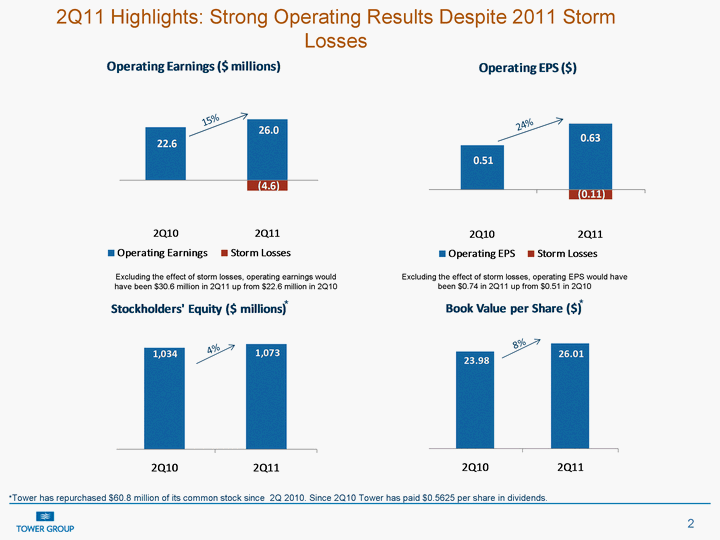
| 2Q11 Highlights: Strong Operating Results Despite 2011 Storm Losses * *Tower has repurchased $60.8 million of its common stock since 2Q 2010. Since 2Q10 Tower has paid $0.5625 per share in dividends. Excluding the effect of storm losses, operating earnings would have been $30.6 million in 2Q11 up from $22.6 million in 2Q10 Excluding the effect of storm losses, operating EPS would have been $0.74 in 2Q11 up from $0.51 in 2Q10 * |

| Tower - Continued Growth and Profitability Excluding the effect of storm losses, operating ROE would have been 11.7% in 2Q11 and 11.5% 6 MO 2011 compared to 9.4% in 2Q10 and 9.9% 6 MO 2010 |

| New Organic Growth Strategy Two-Pronged Organic Growth Strategy Improve existing business units Improve efficiency through product enhancement, automation and cost reduction on our existing business units: Small Business » Mid Market » National Programs » E&S » Personal Lines Create new business units Developed two new business units in late 2010: Customized Solutions and Assumed Reinsurance Considering creating new business units to focus on underwriting products in different industries and territories Product Innovation Capability Substantial improvements being made to product development and business development capabilities Focus on talent acquisition to improve existing business units and create new business units Beginning development of strategic relationships with reinsurance companies and Lloyd's syndicates and other business partners to jointly develop new products |
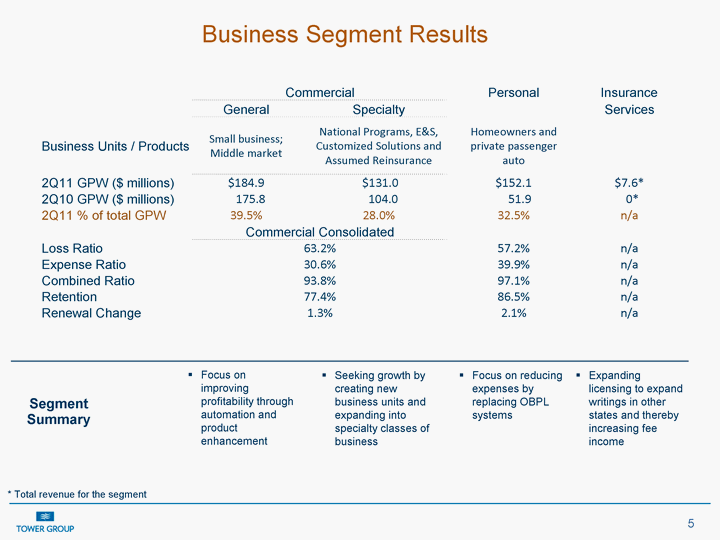
| Business Segment Results Commercial Commercial Commercial Personal Insurance General Specialty Services Business Units / Products Business Units / Products Small business; Middle market National Programs, E&S, Customized Solutions and Assumed Reinsurance Homeowners and private passenger auto 2Q11 GPW ($ millions) 2Q11 GPW ($ millions) $184.9 $131.0 $152.1 $7.6* 2Q10 GPW ($ millions) 2Q10 GPW ($ millions) 175.8 104.0 51.9 0* 2Q11 % of total GPW 2Q11 % of total GPW 39.5% 28.0% 32.5% n/a Commercial Consolidated Commercial Consolidated Commercial Consolidated Loss Ratio 63.2% 63.2% 63.2% 57.2% n/a Expense Ratio 30.6% 30.6% 30.6% 39.9% n/a Combined Ratio 93.8% 93.8% 93.8% 97.1% n/a Retention 77.4% 77.4% 77.4% 86.5% n/a Renewal Change 1.3% 1.3% 1.3% 2.1% n/a Segment Summary * Total revenue for the segment Focus on improving profitability through automation and product enhancement Seeking growth by creating new business units and expanding into specialty classes of business Focus on reducing expenses by replacing OBPL systems Expanding licensing to expand writings in other states and thereby increasing fee income |
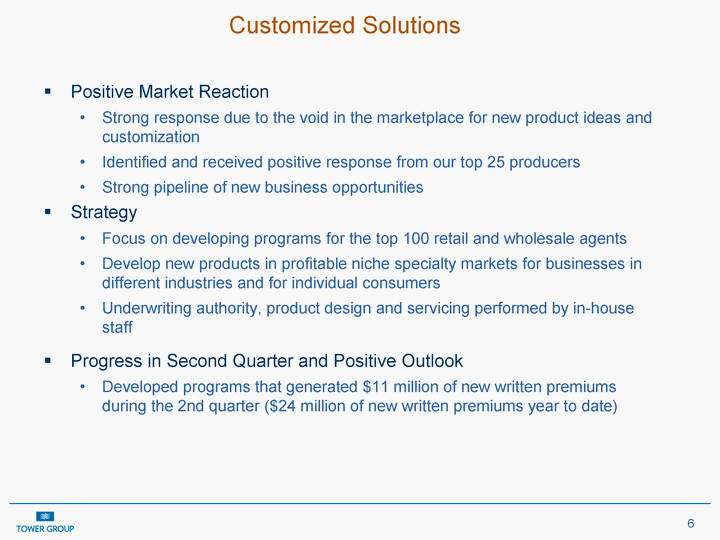
| Customized Solutions Positive Market Reaction Strong response due to the void in the marketplace for new product ideas and customization Identified and received positive response from our top 25 producers Strong pipeline of new business opportunities Strategy Focus on developing programs for the top 100 retail and wholesale agents Develop new products in profitable niche specialty markets for businesses in different industries and for individual consumers Underwriting authority, product design and servicing performed by in-house staff Progress in Second Quarter and Positive Outlook Developed programs that generated $11 million of new written premiums during the 2nd quarter ($24 million of new written premiums year to date) |
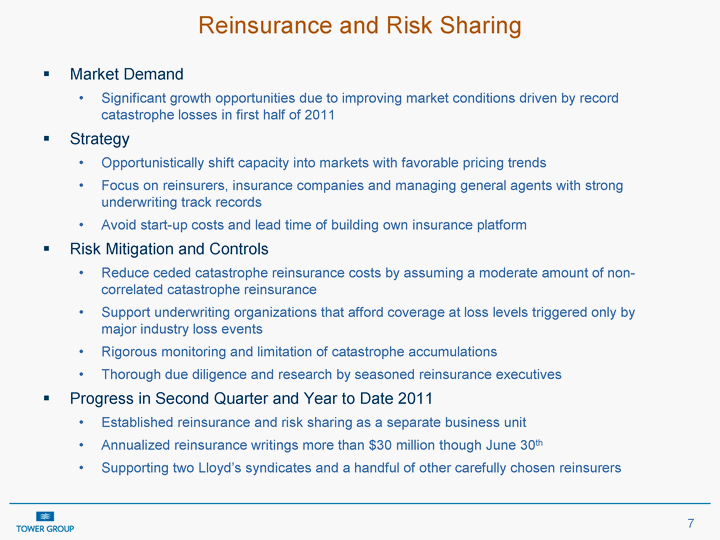
| Reinsurance and Risk Sharing Market Demand Significant growth opportunities due to improving market conditions driven by record catastrophe losses in first half of 2011 Strategy Opportunistically shift capacity into markets with favorable pricing trends Focus on reinsurers, insurance companies and managing general agents with strong underwriting track records Avoid start-up costs and lead time of building own insurance platform Risk Mitigation and Controls Reduce ceded catastrophe reinsurance costs by assuming a moderate amount of non- correlated catastrophe reinsurance Support underwriting organizations that afford coverage at loss levels triggered only by major industry loss events Rigorous monitoring and limitation of catastrophe accumulations Thorough due diligence and research by seasoned reinsurance executives Progress in Second Quarter and Year to Date 2011 Established reinsurance and risk sharing as a separate business unit Annualized reinsurance writings more than $30 million though June 30th Supporting two Lloyd's syndicates and a handful of other carefully chosen reinsurers |

| Acquisitions and Strategic Investments Acquisition Market Conditions Continue to see robust pipeline of acquisition opportunities Many franchises are considering selling due to challenging market conditions Acquisitions Strategy More selective and focused Increase scale of existing business units Create new business units in profitable specialty markets Strategic Investments Strategy Invest in distribution sources and underwriting managers to increase investment income and expand into specialty classes of business |

| Net Loss and Loss Expense Ratio No consolidated annual prior year adverse development since 2004 Consolidated year to date favorable development of $3.2 million Stock companies' year to date adverse development of $7.6 million (includes $6.1 million of December 2010 winter storms and $3.3 million partial settlement of reinsurance dispute) 2011 loss ratio impacted on a year to date basis by winter storm and tornado losses |

| Declining Expense Ratio YTD 2010 BB&T expenses include $4.1 million of New York State workers' compensation surcharges which have not recurred in 2011. |

| Improving Investment Performance Strategy Alternative investment commitment remains modest but should provide higher yield and diversification from interest rate risk inherent in fixed-income investments, and reduce capital markets volatility Examples Private equity type investments in small real estate projects Minority ownership in distribution partners that have a strategic fit with Tower |

| Impact of DAC Accounting Changes on Comparative Numbers DAC accounting change impact is more significant for high-growth companies such as Tower 2011 operating EPS shows 20 - 30% growth over 2010 restated operating EPS 1Q 2Q 3Q 4Q Full Year Growth 2010 Reported $0.39 $0.57 $0.77 $0.84 $2.55 2010 Adjusted for change in DAC 2010 Adjusted for change in DAC 2010 Adjusted for change in DAC $0.29 $0.51 $0.65 $0.80 $2.23 2011 Actual / Guidance* 2011 Actual / Guidance* $0.49 $0.63 $2.70 - $2.90 20% - 30% *As previously announced, due to the recent severe weather-related activity, Tower expects 2011 operating earnings per share to be at the lower end of its previously announced range of $2.70 to $2.90. |
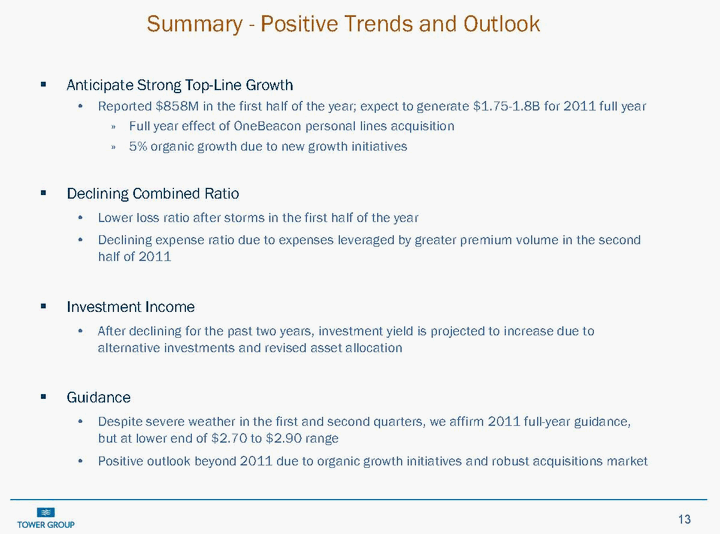
| Summary - Positive Trends and Outlook Anticipate Strong Top-Line Growth Reported $858M in the first half of the year; expect to generate $1.75-1.8B for 2011 full year Full year effect of OneBeacon personal lines acquisition 5% organic growth due to new growth initiatives Declining Combined Ratio Lower loss ratio after storms in the first half of the year Declining expense ratio due to expenses leveraged by greater premium volume in the second half of 2011 Investment Income After declining for the past two years, investment yield is projected to increase due to alternative investments and revised asset allocation Guidance Despite severe weather in the first and second quarters, we affirm 2011 full-year guidance, but at lower end of $2.70 to $2.90 range Positive outlook beyond 2011 due to organic growth initiatives and robust acquisitions market |
